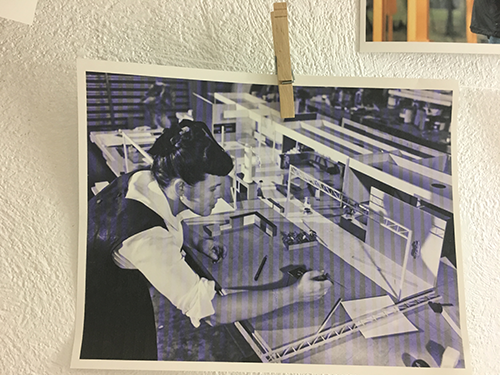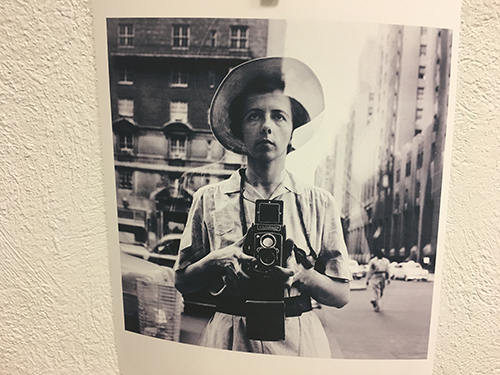Craft comes first. But when speaking with writers, I often find that they struggle to create. They can’t get in a good writing routine, and other important priorities (job, family, home) distract them from writing.
Today I want to talk about how where you create can help you write more.
A year ago I took a big leap: I signed a lease on a private studio where I would do all of my creative work and run my company. At the time, it felt like a scary commitment. But now I realize, it wasn’t the commitment to my landlord that scared me, it was the commitment to myself.

This studio challenged me. I would have to live up to this space.
To do that, I decorated one wall with images of creators who inspire me. As much as I could, I chose photos of them in their creative spaces. Here is JK Rowling in a cafe writing Harry Potter:

Ray Eames designing in her studio:

Kate Bush at the mixing console at what looks to be Abbey Road Studios:

Alexander Calder in his studio:

Vivian Maier on the street taking photographs:

In each of these instances, the creator carefully chose where they created and used this to fuel their creative process. As I look across the room at them, I am reminded that creativity is a process, and that I must invest in it.
With your own writing, I imagine you simply make due with the space that you have. Perhaps this includes a desk in the corner of a spare bedroom, or maybe you have carved out two feet of space on a kitchen counter to place your laptop to write in spare moments in the day.
If I consider the goals of a creative space, they would include:
- Provide clarity on what you need to do. For years, I would write at cafes or libraries. There are many times that I would ensure I had clarity by turning my laptop into a machine with a single purpose. I would remove all other files from the desktop of the computer except for the one document I was currently writing. In my mind, this machine had a single purpose. It was no longer a computer that could do 1,000 things, it was now only a tool to work on a single piece of writing.
- Remove you from distraction. For well more than a decade, I have been able to have a private office at home in a spare bedroom. This space has a door that not only closes, but locks! Of course, my studio has the same thing. But when I wrote in public, at cafes and libraries, I would choose my seat carefully. Sometimes I liked the white noise of being right in the middle of a busy space. Other times, I would go to a library two towns away, and sit in a corner facing the wall. I would also wear headphones while writing, listening to music. The music would remove me from my physical context, and focus me on the task at hand. Headphones are also a wonderful signal to others that you shouldn’t be disturbed. Don’t just use earbuds, go and buy those big headphones that cover your ears! Author Tim Ferriss says that he will often wear headphones when working out, but won’t be listening to anything. He wears them as a signal to others that he is concentrating and shouldn’t be disturbed.
- Incentivize you to create. You want to feel a sense of accomplishment when you create, right? For me, I write using Scrivener, and it has this wonderful little meter that I can setup. I can choose a goal for a writing session by word count, and the meter will change from red to orange to green as I come closer to my goal. If you are ideating or editing, it may be more difficult to quantify results. Consider hanging a simple calendar in your creative space where you get to mark a big bold X on every day that you create. When I wrote at cafes, I would sometimes buy myself a treat if I reached a certain writing goal, such as writing for an hour. Brownies an be wonderful creative tools!
- Remove all barriers to entry for getting started. Do you write on a laptop that takes 7 minutes to boot up, has a desktop filled with 100 files, and it sits on a crowded desk with all of your bills, recipes, and mail? If so, that means that just to get to your writing means you are forcing yourself to wade through all of that muck first. Why put your writing space in the middle of a crowded jungle that has no clear roads to it? Schedule time with your family if you need to where you can write distraction-free. Block off that time in your calendar so that it is as unmovable as an important doctor’s appointment. Up above I said that I had to live up to my studio space. Find ways to do that in your own life — make your creative work an obligation that is as important as any other in your life.
- Have all of the tools you need at the ready. When I spoke to author Dani Shapiro she talked about how the tool that most writers use is also the source of their greatest distraction: the computer. People struggle to not be distracted by email, social media, or the news. Consider buying a used laptop that is just for writing. During a Mastermind session I ran last year, three writers in the same group admitted that they wrote on an old-fashioned word processor! Why? Because it didn’t have a web browser, and didn’t even connect to the internet! Consider all of the tools you need to create invest in them. For the first few months in my studio, it was largely empty. It took awhile to give myself permission to invest in books, supplies, other materials that I can use in my creative process. Each expense felt like a debate in my mind about whether it would have a return on investment. But then, I would look to the photo of Calder’s studio and see raw materials scattered across his floor; I would look at photos of Ray Eames’ studio and all of the shelves of materials that she kept in case she needed them; I would look at Kate Bush in the studio, with thousands of dollars of gear ready at a moments notice.
What difference has a private studio made in my life? I create more consistently, I create for longer periods of time, and I feel more focused while writing.
But what if you are someone who simply can’t carve out your own creative space? You work long hours at your day job, you have a long commute, and your home is a one-bedroom apartment that you share with your spouse and two children? Is a creative space essential?
Nope.
But I would encourage you to consider how you can re-create the list of goals above without a dedicated creative space. When I interviewed author Michael LaRonn, he told me that by installing a writing app on his phone, he would steal small moments throughout the day to write his novels 100 words at a time. He would do this while on line at the food store, while waiting for his wife at Target and in other small moments that most of us would simply check Facebook or the news. He turned distracted time into creative time.
Likewise, author Tammy Greenwood told me (here and here) how she would write scenes from her novels in her mind while waiting in the car to pickup her kids at school. When she got to the keyboard later in the day, all she had to do was put down what was already written in her mind.
Stacy McAnulty told me that wrote her first book one-handed, without punctuation or capitalization, because she wrote while breastfeeding her first child using her other hand.
In each instance, these writers developed a writing routine that worked with the resources they had at the time.
I’d love to know: where do you create?
Thanks!
-Dan
